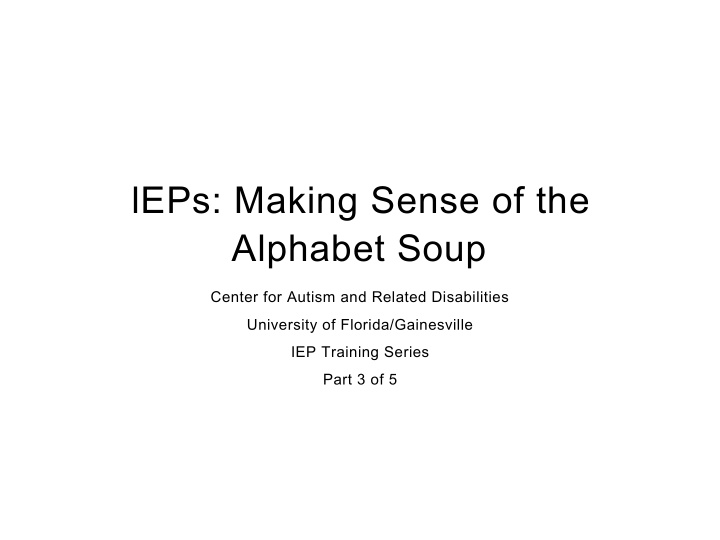



lEPs: Making Sense of the Alphabet Soup Center for Autism and Related Disabilities University of Florida/Gainesville IEP Training Series Part 3 of 5
Audience • The content presented in this series is intended to benefit parents of students with disabilities who are eligible for services and an IEP under IDEA. • However, all interested parties, including family members, educators, related service professionals, and school administrators are welcome and encouraged to participate in this series.
What we will cover today • A little background: IDEA • Making sense of the acronyms
Learning objectives • Explain purpose of IDEA • Define LRE, FAPE, and IEP
IDEA: A brief history • PL 94-142, The Education for All Handicapped Children's Act of 1975 was the first law that provided a free and appropriate education for students with disabilities. Until this time, school districts often excluded students with disabilities, especially those with more complex support needs. •The Individuals with Disabilities Education Act (IDEA) is the law that ensures all students have access to a free and appropriate public education regardless of disability. • This law is a reauthorization of the 1975, Education for all Handicapped Children Act. • IDEA was introduced in 1990 and was amended 1997 and reauthorized in 2004.
IDEA is the law that requires lEPs for children ages 3 through 21 who have disabilities that affect their ability to learn.
To qualify for an IEP, the student must have one of the following classifications •Autism Traumatic brain injury •Hearing impairment Emotional disturbance •Deaf-blindness Visual impairment •Intellectual disability Multiple disabilities •Speech/language impairment Orthopedic impairment •Specific learning disabilities Deafness •Developmental delay Other health impairment
LRE • What it is: Least Restrictive Environment • “States must have procedures to ensure that, to the maximum extent appropriate, children with disabilities, including those in public/private institutions, are educated with non-disabled children and that removal from the regular education environment only occurs when education in that setting, with supplementary aids and services, cannot be achieved satisfactorily.”
FAPE • What it is: Free Appropriate Public Education •What it means: Students with disabilities are guaranteed access to academic, nonacademic, and extracurricular activities similar to those of their peers. • This means there is a zero reject policy.
IEP • What it is: Individual Education Plan (Program) • What it means: Established by Part В of IDEA to ensure that all students ages 3 through 21 received FAPE, individualized instruction • Every IEP must include: • Present level of performance • Goals/objectives • Services/Supplemental Aids • The extent to which the child will not be in the general education classroom with justification • Transition plan (14 yrs or older)
IFSP • What it is: Individual Family Service Plan • What it means: for children with disabilities ages birth to two; documents support to the child and family through Part С of IDEA
ITP • What it is: Individual Transition Plan • What it means: starting at age 14, the team starts planning and setting goals for transition beyond school (when the child turns 22) • Includes planning for post-secondary schooling, job placement, housing options, interest development, and more
504 Plan • Covered by civil rights law (Rehabilitation Act) • Applies to all students with qualifying disabilities • Informal process • Schools do not receive extra funding for implementing the 504 • Does allow for accommodations and modifications, adaptive tech when appropriate, and related services
PLOP • What it is: Present Levels of Performance • What it means: a description of your child's current skills across learning domains • Academic • Social/communication • Behavior • Independence/adaptive • PLOPs should be very detailed and should describe all that the student can currently do independently • PLOPs are used to identify "next steps" (aka, goals and objectives on the next IEP)
ADA • What it is: Americans with Disabilities Act • What it means: Civil rights law that prohibits discrimination based on disability • Disability is defined by the ADA as "...a physical or mental impairment that substantially limits a major life activity/' • Covers such things as: • Employment • Housing • Transportation • Telecommunications
F BA • What it is: Functional Behavior Assessment • What it means: when your child's behavior is negatively impacting his learning or other students' learning, an assessment may be conducted to determine • Function (purpose) of the behavior • Triggers (precursors) for the behavior • Current consequences for the behavior • Is required before a behavior plan (BIP) can be implemented
BIP • What it is: Behavior Intervention Plan • What it means: A formal plan to address challenging behaviors • Should include • Identification of function of behavior • Strategies to prevent the behavior • Proactive teaching strategies • Replacement behaviors for the inappropriate behavior • Description of how to respond to appropriate and inappropriate behaviors • Data on behaviors must be collected and analyzed regularly
RTI • What it is: Response to Intervention • What it means: a multi-tier approach to the early identification and support of students with learning and behavior needs. • Struggling learners are provided with interventions at increasing levels of intensity to accelerate their rate of learning. • Educational decisions about the intensity and duration of interventions are based on individual student response to instruction. • 1. highly-qualified, scientifically-based classroom instruction • 2. ongoing student assessment • 3. tiered instruction • 4. parent involvement
ESY • What it is: Extended School Year • What it means: When deemed appropriate by the team (aka., when it is likely that the student will lose skills over the summer break), the student receives services during the summer months • Goals and objectives for ESY should be taken directly from the IEP
Thank you for watching IEP Series Part 3: Alphabet Soup Be sure to watch the other 4 parts of this series!
Recommend
More recommend